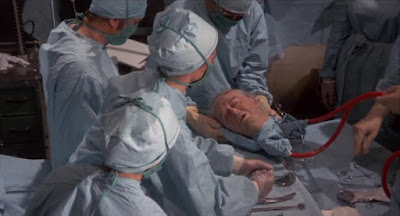White Dog (1982) Co-writer/director
Samuel Fuller’s tale of pets and prejudice (co-written by Curtis Hanson and
based on a novel by Romain Gary) was deemed too volatile by Paramount when it
was completed, and was promptly buried before it saw a release. It eventually
made it to theaters nine years later in limited release, but remains seldom
seen. When a young actress (Kristy McNichol) accidentally runs into a dog with
her car, she takes him home and nurses him back to health. She soon learns there’s
more to the dog’s history when she discovers he’s been trained to attack black
people. In a last-resort effort, she enlists the aid of animal trainer Keys (Paul
Winfield), who makes it his personal mission to cut out the ingrained behavior
like a cancer. The story is told in broad strokes, filled with some implausible
situations, yet, the core ethical/moral dilemma shines through, like a
modern-day fable. The story follows an inevitable trajectory, leading to a sobering
ending.
Rating: ***½. Available on DVD.
Under the Skin (2013)
I admired Under the Skin for its
artistic integrity, even though I didn’t particularly enjoy it. Scarlett
Johansson stars in this arthouse sci-fi/horror hybrid as an attractive, albeit
emotionless woman who roams the city streets in a delivery van, picking up single
men. She lures them to her home with the promise of anonymous sex, where they’re
dissolved in a liquid substrate that oozes from the floorboards. The ritual
repeats with a series of different men, from different walks of life. Although
the film successfully maintains an eerie sense of dread, it plods along at a
glacial place, and remains as emotionally distant as its main character. Johansson
deserves kudos, however, for her icy performance, and for branching out from the
usual Hollywood claptrap. Ultimately, the film’s message, if any, gets
obscured. Whether this little Scottish independent production is a cautionary
tale about dating, or judging by surface appearance, or something similar, is
anyone’s guess.
Rating: ***. Available on Blu-ray and DVD
Jack’s Back (1988)
Writer/director Rowdy Herrington’s (Roadhouse)
murder mystery aims high, but never quite lives up to the promise of its lurid
subject matter. James Spader stars in a dual role as identical twins Rick and John
Wesford. While investigating a series of murders fashioned after Jack the
Ripper, medical internist John is killed. Rick follows his twin’s footsteps,
attempting to unravel the mystery. Considering the macabre template of the
original murders, it fails to generate much in the way of suspense or thrills. Spader
is likable in the lead role(s), and Robert Picardo is good as a psychiatrist. It’s
too bad the story never gets out of second gear. Jack’s Back would have been a decent television movie when it came
out, but as a theatrical production, it lacks the punch the premise demands.
Rating: **½. Available on Netflix Streaming (as of
today’s date)
The Dark Backward (1991)
This sporadically amusing film from writer/director Adam Rifkin has all the
trimmings of a cult film, but never quite hits the mark. The story takes place in
some sort of ill-defined post-apocalyptic landscape where all of the consumer
products are dominated by one brand. Judd Nelson stars as the nebbishy Marty
Malt, a garbage collector who moonlights as an inept stand-up comic. One day, a
third arm grows out of his back, and he suddenly becomes a hit. One of the
biggest problems with the film is it works a little too well convincing us he’s
a terrible comedian, but falls flat with the surrounding comic scenes. The rest
of the movie is an endurance test, seeming at least 20 minutes too long. Bill
Paxton appears as Marty’s obnoxious buddy Gus. Normally, Paxton’s appearance in
a movie is a good thing, but in this instance, I wanted to punch him in the
face. Wayne Newton as a sleazy agent isn’t much better. One of the only bright spots is James Caan as
an unscrupulous, money-grubbing doctor. The
Dark Backward comes close, but no cigar.
Rating: **½. Available on DVD.







































